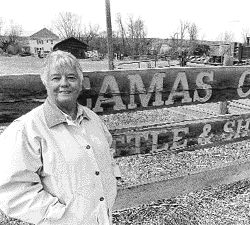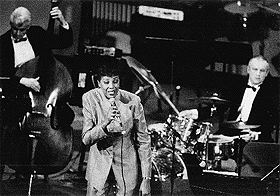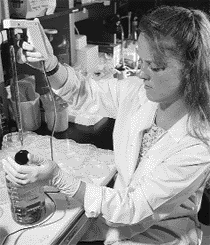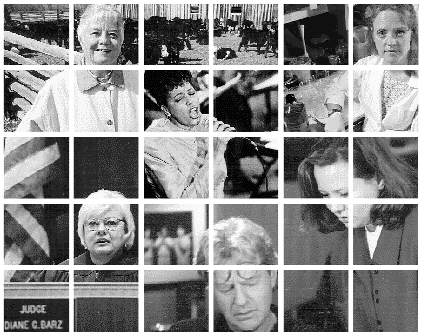|
 |
| Mary Doggett at her ranch near White Sulphur Springs, the Camas Creek Cattle and Sheep Company. |
"It hasn't been dull," Mary Doggett says of a life that took her from a Miles City childhood to a ranch near White Sulphur Springs. Along the way, she became a schoolteacher, raised four sons and worked for the state library system. And though she has endured nearly half a century of hard winters, lost livestock and ruinous markets, Doggett counts herself blessed.
Doggett graduated from UM in 1952, taught high school and, two years later, married her college boyfriend, Jeff Doggett. The new bride soon found herself sitting down to dinner at the Camas Creek Cattle and Sheep Company outside of White Sulphur Springs with "thirteen cowboys and a crabby cook." It was to be her home for the next forty-five years.
Doggett was no stranger to the cowboy way of life, but she still had to learn skills she never studied at UM: calving, branding, business management and finance, to name a few. Add to that the task of raising four sons, serving on the Montana State Library Commission and the local school board, and Doggett's life began to resemble the mythos of the American West: full of rugged beauty, endless toil, simple pleasures and an abiding love of place. "Ranchers were the original environmentalists," Doggett says. "We take care of the land. We have no choice."
When asked to compare her career with that of women today, Doggett alludes to the radical changes in women's roles. "It was different then," she says. "I followed a very traditional route, but I'm lucky to have three remarkable daughters-in-law. They have their professions and they take care of their families." She pauses, then adds, "With help from their husbands, of course."
Diane Barz - Setting Precedent
 |
| Diane Barz, a judge for the Thirteenth Judicial District. |
By any measure, Diane Barz's life has been a classic American success story. As an attorney and judge, she has gone where no woman had gone before, becoming the first woman to sit on the Montana Supreme Court in 1989. Yet it is also characteristic of her that she gave up the prestige of the high court in Helena to return to her family in Billings. That decision was controversial, opening her to criticism that she had too quickly abandoned a position always denied to women, but Barz has few regrets.
Born in Bozeman, Barz attended college at Whitworth in Spokane, before entering UM's law school in 1965. The only woman in the class, Barz felt accepted by male classmates and professors, choosing to fit into, rather than challenge, the men's-club atmosphere that characterized the legal profession. In 1968 she won a coveted clerkship at the Montana Supreme Court only, she learned later, after much heated discussion. And when she started work, she was puzzled when Justice Hugh Adair would silently hand her quarters-not something he did with the male clerks. Eventually, she realized the Justice intended the money for coffee.
Following her year and a half of clerking at the Supreme Court, she took a job in Billings as deputy county attorney. In 1974 she moved to the private law firm of Doris Poppler, who taught Barz negotiation and mediation skills. Five years later, when an uncontested seat opened up on the newly created Thirteenth Judicial District Court, Barz decided to run and won. "I wanted to be an active youth court judge," she says. "Back then we were still putting young kids in jail with career criminals." Barz established the Youth Court Conference Committee, which finds alternative punishments for young offenders.
In 1987 Barz's historic appointment to Montana's high court brought her professional challenges and prestige, but separated her from her family. Eighteen months later, she made the decision to step down. "I was facing a contested statewide election and would have had to raise a substantial amount of money," she explains. "My family was still in Billings; my son was only thirteen. I needed to be home."
Barz has regained her seat on the district court. But she says her Supreme Court experience deepened her respect for the complexity of the law. "I approach questions from more angles now," she says. "You realize that men of wisdom can differ greatly on specific questions."
Dee Daniels - Changing her World with a Joyful Voice.
 |
| Vocalist and alumna Dee Daniels performed in the University Theatre for UM's Jazz Festival, April 30. |
With seven jazz CDs to her name and an international performing career, Dee Daniels is no stranger to success. Well known in Europe, where she lived in the 1980s, she now divides her time between a home in Vancouver, British Columbia, and the road. But for all her globe-trotting, Daniels says her time at UM profoundly influenced her.
At UM in 1967, Daniels was one of two black women who were recruited by UM because the six black players on the football team had begun dating white women and there were complaints. She immediately became friends with Esther Hadley, the only other woman to accept the offer. When the two decided to live off campus, what they experienced shocked Daniels, who had grown up in Los Angeles. "It was the first time I really encountered discrimination," she says. "Hands would suddenly take down 'For Rent' signs from windows as we approached.
To its credit, the University community responded with strong support. President Robert T. Pantzer, Dean of Students Andrew Cogswell and Professor Dexter Roberts organized the Action Seminar, which sent out black students to rent apartments. When they were refused, white students went to the same address and got the rental. Rallies were organized, and Daniels and Hadley became symbols of the civil rights struggle going on across America. UM soon began recruiting black students (other than football players) and hired a black professor, Ulysses Doss. Missoula began to change, too. Practices like housing discrimination disappeared as the community declared them unacceptable.
Daniels graduated in 1970 prepared to teach art. Instead, the young woman who grew up singing and playing piano in her stepfather's Baptist church found herself drawn into music. After landing her first full-time teaching job in Seattle, Daniels began performing regularly enough with "Dee Daniels and Dynamite" to quit her day job.
Rock and roll, however, was not her destiny. Daniels quit to start her own group, singing "jazz and blues with a tinge of gospel" and started improvising "to keep from getting bored." In 1982 she was "in a comfortable rut" when she met sports artist Leroy Neiman. After hearing Daniels sing, Neiman helped her move to Europe where, like many black performers, she found an enthusiastic audience. "As an American black female singer," she recalls, "I didn't have any problems anywhere."
Despite her successes, Daniels' UM years are a bench mark. "I consider my time in Missoula to be one of the highlights of my life," she says. "It made me who I am today."
Erika Bishop - Where East Meets West
 |
| Erika Bishop with Cheech Martin, co-star of CBS prime time series, Nash Bridges. |
Erika Bishop straddles two worlds. In New York, she is the respected producer of big-time television shows like CBS This Morning and The Joan Rivers Show. But her heart-along with that of her husband, NBC News reporter Shane Bishop- stubbornly resides in Montana.
Although Erika was born in Spokane, Washington, most of her family was from Montana. Her parents were born in the state, and her uncles Steve and Dick Riddle were members of the legendary Mission Mountain Wood Band. After her father died, the family moved to New York but every summer the household headed west, she says, "in the back of the LTD."
When Erika entered UM's journalism school in 1984, she showed up wearing punked-out hair and East Village black, and the local boys took notice. Especially Shane Bishop, a clean-cut fellow journalism student from Conrad, Montana. They won journalism scholarships, formed a lasting relationship and became protégés of the late Professor Joe Durso, Jr.
One night in 1987, shortly after Erika graduated and married Shane, the two were discussing their futures over beers at the Missoula Club. They agreed that whenever one of them got a better job, the other would move. They hoped this plan would get them to New York, careers intact, within five years.
They made it in less than two. Along the way, Bishop moved from in front of the camera to behind it, becoming manager of a low-power TV station in Pennsylvania and learning the nuts and bolts of video production. In New York she was hired as a freelance segment producer for CBS This Morning, the Sally Jessy Raphael Show, the Joan Rivers Show, followed by a stint on The Maury Povitch Show on the Lifetime Cable Network.
These days, Erika has exchanged her Manhattan lifestyle for a home in the New Jersey suburbs with the couple's three-year-old daughter, Meredith. She produces shows for The Food Network, while Shane is a producer at Dateline NBC. Nevertheless, she feels Montana's influence every day. "I think my values are very different from those of East Coast women," Bishop says. "I got married when I was twenty-three. I quit jobs to be with my husband. I quit jobs to have a baby. We say the same prayer that Shane's family always said before dinner, which we eat together every night. We have a very normal life...for Montana."
Rachel LaCasse - On the Frontiers of Science
 |
| Rachel LaCasse in her lab at the University of Alabama. |
In 1994 Rachel LaCasse, a graduate student in biology, was studying feline leukemia, a common disease of cats similar to AIDS. Both attack the body's immune system. Both are caused by retro viruses (the feline leukemia virus is known as FIV, the AIDS virus as HIV). Enter Jack Nunberg, a virologist with a hunch about how to create an HIV vaccine. LaCasse was a natural for the projects and soon she was putting in long hours at UM's Montana Biotechnology Center, which Nunberg heads.
Researchers have long been frustrated in their search for an effective AIDS vaccine. Their efforts focused on blocking the virus before it binds with-and destroys-the body's T-lymphocyte cells, one of the primary defenders of the immune system. Nunberg suspected these earlier vaccines were attempting to block the virus at the wrong step in the process. LaCasse played a key role in helping Nunberg try a different approach: a "fusion-competent" vaccine that disrupted the virus during the infection process itself. "My primary responsibility," she says, "was to make the vaccines, inject the mice and test the mice."
By early 1998, the team knew they were on to something remarkable. Trials of the vaccine had shown it effective against twenty-three of twenty-four real-world strains of HIV, a hitherto unheard of result. When the results were published in the January 15, 1999 Science, world attention shone on Nunberg and his team, but by that time LaCasse had graduated and accepted a postdoctoral fellowship at the University of Alabama, one of the top AIDS research centers in the world.
LaCasse doesn't know yet where this opportunity of a lifetime will take her, but she knows what she wants. "I'd like to have my own lab someday, ideally somewhere in the Northwest," says LaCasse, who grew up in Frenchtown. And though she is forging a career in the male-dominated world of science, LaCasse doesn't seem worried. "Nobody should be intimidated," she says. "You just work hard and take things in stride. There are always opportunities."
![]()
Patrick Hutchins is a frequent contributor to the Montanan.
